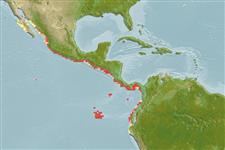Common names from other countries
Environment: milieu / climate zone / depth range / distribution range
Ecologia
; intervalo de profundidade 0 - 40 m (Ref. 4). Tropical, preferred 27°C (Ref. 107945); 28°N - 6°S, 115°W - 77°W (Ref. 112659)
Eastern Pacific: From Baja California Sur to the west coast of Peru and the Galapagos Islands.
Length at first maturity / Tamanho / Peso / Idade
Maturity: Lm ?, range 4 - ? cm Max length : 32.0 cm TL macho/indeterminado; (Ref. 4); 30 cm TL (female)
It has lengths of 32 cm (male) and 30 cm (female), maximum total body length; 1 to 13 cm (male) and 1 to 12 cm (female), carapace length (Ref. 4). Maximum depth from Ref. 112672.
Life cycle and mating behavior
Maturidade | Reprodução | Desova | Ovos | Fecundidade | Larvas
Members of the order Decapoda are mostly gonochoric. Mating behavior: Precopulatory courtship ritual is common (through olfactory and tactile cues); usually indirect sperm transfer.
Holthuis, L.B. 1991. (Ref. 4)
Status na Lista Vermelha da IUCN (Ref. 130435: Version 2024-1)
Status no CITES (Ref. 108899)
Not Evaluated
Not Evaluated
Uso pelos humanos
Pescarias: espécies comerciais
FAO - pescarias: landings | FIRMS (Stock assessments) | FishSource | Sea Around Us
Ferramentas
Fontes da internet
Estimates based on models
Preferred temperature
(Ref.
115969): 22.7 - 29.1, mean 27 (based on 170 cells).
Resiliência
Elevada, tempo mínimo de duplicação da população menor que 15 meses (K=0.38-0.45).
Vulnerabilidade
Low to moderate vulnerability (28 of 100).
